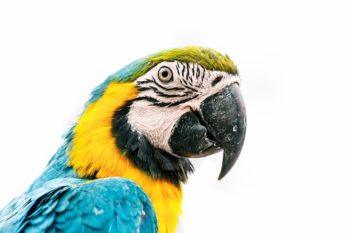Dirty Secret: Researcher Studying Why Parrots Eat Soil

Parrots are among the world’s most beautiful birds, but many South American parrots have a pretty dirty little secret that researchers want to know more about: why their favorite meal isn’t fruits or nuts, but soil.
Finding a reason for their at-times peculiar eating behavior could solve some mysteries about the colorful birds and might even lead to ways of stopping their rapidly declining numbers.
Donald Brightsmith, a parrot specialist at Texas A&MUniversity’s Schubot Exotic Bird Center, has made numerous trips to Peru – ground zero for many types of parrots – and examined large clay licks in the Amazon lowland area of Tambopata in southeastern Peru. There, a 1,500-foot-long clay lick is a source of food for several species of parrots who consume the dirt on a daily basis, as do numerous animals, such as monkeys, deer and others.
Why parrots engage in geophagy – the intentional eating of soil – is a question bird experts have wondered for decades, and Brightsmith believes he may have found some answers.
“They eat the soil for the nutrients in it, mainly sodium,” he explains.
“We found out that some of the soil they eat contains 40 times the amount of sodium of others in the same region. So the parrots get the salt they need and want, and the soil there also contains calcium and iron,” he says. “Plus, we also believe they eat the soil for protective reasons. The soil binds to the toxins in the plants they eat, and helps protect them from the toxic effects.”
But the mystery doesn’t end there, Brightsmith says.
While some parrots make daily trips to the clay licks, others never go near it, raising the question of why some birds eat the soil while others refuse to do so.
“We documented that the parrots that do go to the clay licks make a considerable effort in doing so,” he notes.
“They travel for miles and miles and stay there for a long time, so they make a substantial investment of their time and energy to get there. But other parrots in the same area seem to care less and never go near the spot.
“Why some birds crave the licks and others don’t is one big question we’d like to answer.”
Parrots are highly intelligent creatures that can live up to 50 years and often outlive their owners. They can be taught to speak English words or phrases, “or any language, for that matter,” says Brightsmith.
Experts say about 94 species of parrots are either endangered or facing extinction. The colorful birds have been hunted for decades for sale in the pet industry, and the clearing of their native rainforests for development or agriculture has added to their declining numbers.
For every bird sold in a pet shop, it is estimated three others died, either by poor capturing methods, unsafe confinement, faulty transportation procedures or other means.
“A lot of the bird trappers go to these clay licks because they know it’s the best place to get a lot of parrots at one time,” Brightsmith says.
“But we also know that there is a significant amount of parrots that don’t go to these licks and never consume the soil. So we would like to find out why.”
His work is being funded by a grant from the Schubot Center, Earthwatch Institute, Rainforest Expeditions and private donors.
Media contact: Keith Randall, Texas A&M News & Information Services.





